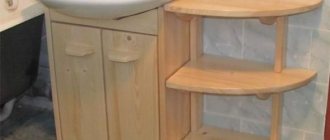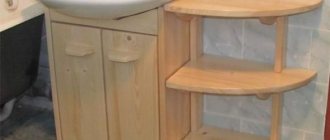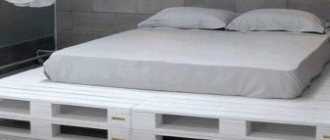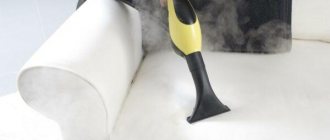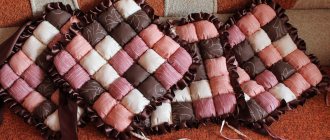Light, elegant white tulle adds more light and air to the space, and visually expands it. Whatever the current trends in interior design, the classics remain timeless. However, white color has a “capricious” character - over time, yellowness or grayness appears on it, which does not disappear after regular washing. Read our article about what to do in such a situation and how to bleach tulle at home.
Before washing and bleaching, be sure to read the label - each type of fabric has its own bleaching method.
How to bleach tulle from gray and yellowness at home
The gradual transformation of white air curtains on the windows into gray-yellow and untidy in appearance as a result of exposure to sunlight, dust, smoke, the appearance of stains from grease and other similar contaminants on the curtains is a common problem. But the situation can be corrected using different approaches.
Salt
Salt is always at hand, so it can be called the number one remedy for whitening tulle, and it has been used for decades for this purpose.
- To bleach curtains with salt, you need to dissolve it in warm water. It is better to take coarse salt, but if this is not available, use fine salt. The concentration required for the procedure is achieved with two level tablespoons dissolved in a liter of warm water. The concentration may be higher if it is necessary to bleach very dirty tulle.
- You can immediately pour powder suitable for washing curtains into the same solution, or you can do this a second time after soaking them in a salt solution.
- Immerse the tulle curtains completely in the resulting solution and leave them for a couple of hours or more.
- For a better effect, the tulle is periodically removed from the solution, turned over and lowered again.
- After this, the curtains are washed by hand or in a washing machine.
Ammonia
To bleach yellowed or overly dirty nylon curtains, a ten percent ammonia solution in combination with hydrogen peroxide is used.
- A solution is prepared from one tablespoon of ammonia, two tablespoons of peroxide and 7 liters of warm water.
- Immerse clean tulle, washed in the usual way, into the composition for 30 minutes or a little more.
- The tulle is removed and rinsed.
Zelenka
Usually this product is used as an antiseptic, and not even in all countries of the world. Most likely, many countries around the world don’t even know about the use of brilliant green in the process of washing curtains and other white items. But housewives in the USSR knew this very well and often used this product to give white things a bluish-emerald tint. Just white things became bright white and pleasing to the eye.
- To do this, the tulle is first soaked for several hours in a soap solution.
- Then it is washed in the usual way by hand or in the washing machine.
- The brilliant green is connected already at the rinsing stage.
- A solution is prepared (it can be prepared while soaking the tulle or in advance) from three tablespoons of salt (without a slide), a few drops of brilliant green (5-7 drops are enough) and a glass of warm water. First, the salt is ground with an antiseptic, and then added to the water and stirred. The composition is left until completely dissolved, mixed again and filtered. The finished solution without sediment is added to the rinsing water. It is better to take a larger container for this.
- Washed curtains are placed in this water and rinsed on different sides.
With the help of greenery you can not only brighten up new curtains, but also practically revive old and yellowed ones.
Blue
The principle of action of blue is the same as that of green. Rather, it does not completely whiten, but masks the yellowness, making the fabric snow-white with a bluish tint. Blue is used only in the process of rinsing things.
- The washed curtains are placed in a large container with the prepared composition.
- The solution is prepared either from a powder or liquid.
- For 10 liters of cool water, take half a teaspoon of powder or 1 cap of liquid blue, mix everything well. In the case of powder, it is better to strain the resulting mixture.
- The tulle is rinsed in blue water and hung without spinning. After the procedure, you can rinse again in clean water.
You can turn curtains blue in an express way: in an automatic washing machine.
- First, tulle curtains are washed on a delicate cycle.
- 1 cap of blue is poured into the conditioner compartment and the rinse mode is started. Blue can be added immediately during the washing process by running an additional rinse after that.
Boric acid
Boric acid powder or alcohol solution can be used to bleach white items, including tulle curtains.
Before washing, curtains are soaked in the composition (10 grams or 1 tablespoon of alcohol solution per liter of water) for an hour and a half, and then washed as usual.
The indicated concentration is suitable for cotton and linen tulle; for synthetic tulle, the dosage is halved.
Laundry soap
Soap effectively fights old stains, yellowness and grayness. It can restore the whiteness of old curtains and give them new life.
- You need to grate a piece of laundry soap on a coarse grater. Pour the resulting crumbs into an enamel bowl with water heated to 60-70 degrees, bring to a boil, stirring, and remove from heat.
- Cool the mixture to 40 degrees and place the curtains in it. Stains can also be additionally rubbed with soap.
- Leave for a couple of hours.
- After soaking, wash the stains by hand.
- Next, we wash the tulle either in the machine or by hand.
Starch
Typically, starch is used to stiffen cotton and linen materials. For example, starched white napkins always look beautiful and can be used to decorate a house in a rustic style and its varieties: Provence and country. Starch will also help restore the snow-white color of tulle cotton or linen curtains.
- Curtains are first washed with powder.
- Dissolve one glass of starch in a glass of warm water.
- The resulting mixture is poured into a large basin of water. The indicated amount of product is calculated for 10 liters of water. If the curtains are large, then the dosage needs to be increased.
- Soak the tulle for several hours (5-6 hours are enough to bleach the tulle).
- Rinse.
Digestion
An unjustifiably forgotten “old-fashioned” method with which you can wash tulle so that it is snow-white.
Very dirty curtains are first soaked and washed in any powder and rinsed.
- Take an enameled or zinc tank, a large saucepan or basin, pour water (about half the capacity).
- Grated laundry soap or bleach, for example, Persol, dissolves in water. You can also use other means for boiling: any other type of powder or bleach, salt, soda, peroxide, potassium permanganate and others. But it is not recommended to use chlorine-containing products for this procedure, since chlorine compounds that are harmful to health will be released during boiling. In any case, it is better to open the windows during the manipulations.
- The curtains are placed in a prepared container with washing components and boiled with periodic stirring with wooden tongs for an hour.
- The time can be increased to two hours if it is not possible to wash the tulle until it is white within an hour.
It is important to remember that only materials made from natural fibers can be boiled. If you have doubts about the composition of the fabric, then it is better not to use this method, but to look for another solution on how to whiten curtains.
Soda
Tulle can also be bleached using baking soda. This is done before washing.
Warm water is poured into a basin or bucket, a glass of soda is poured in, and stirred.
The curtains are soaked for 2-3 hours and then washed.
How to bleach tulle with soda - video
Lemon acid
Acids promote the breakdown of fats and help remove stubborn stains from fabrics.
Citric acid is used after washing.
Place washed curtains in the solution. The mixture is prepared from a packet of the substance weighing 25 grams for every 2 liters of water. The tulle is in the solution for about half an hour, and then rinsed.
How to bleach tulle with potassium permanganate
Potassium permanganate is one of the means that can be used to whiten yellowed curtains.
- To do this, potassium permanganate crystals are diluted in water until a dark pink color is obtained.
- The mixture is poured into a basin.
- Tulle is placed in the basin for about 30 minutes.
- Washing is carried out after soaking in the usual way.
Types of bleaches
Bleaching agents for curtains and tulle are divided into three types depending on the composition of the components and the principle of operation.
Chlorine-containing
The composition includes sodium hypochlorite - an aggressive compound that penetrates deep into the fabric structure, destroying dirt and grease. The main advantage of chlorine-containing bleaches is their low price. However, chlorine is harmful to the respiratory system, causes burns upon contact with skin, and can lead to allergic reactions.
Another serious disadvantage of chlorine bleach is its short shelf life (up to 9 months). The product partially loses its properties due to exposure to direct sunlight and completely when frozen. Therefore, do not place a bottle of liquid on the balcony or in the basement during the cold season.
Chlorine-containing bleaches are completely unsuitable for bleaching tulle containing the following threads:
- silk;
- synthetic (polyester, polypropylene);
- nylon.
You will not wash nylon tulle, curtains made of tulle, chiffon, or organza with it. A reasonable question arises: what products can be bleached with a product containing chlorine? Only 100% cotton or linen tulle. Although they are found in houses and apartments, they are rare. In other cases, use other bleaches.
Chlorine products generally should not be used to bleach fabrics in the washing machine. It reacts with the metal trim of the drum and destroys the rubber outlet pipes.
Oxygen-containing
Available in the form of liquid concentrates and powders. Suitable for washing machine use. The composition includes hydrogen peroxide or sodium percarbonate, other additives - surfactants, fragrances. During washing, the active substance disintegrates, forming oxygen bubbles that oxidize gray plaque particles. The product does not leave an unpleasant odor on the curtains.
It is oxygen-containing bleach that is excellent for ridding curtains of gray plaque. On the packaging (bottle) of each product it is written which materials can be bleached with its help.
Optical
Contains particles with reflective properties. In fact, optical brighteners do not remove gray plaque, but mask it. But visually the tulle looks snow-white. As a rule, curtain washing products contain some percentage of optical brightener. The downside is the high price.
Special products for washing tulle
Curtains can be put in order not only with the help of home remedies, but also with the help of special purchased ones. The best products that return curtains to their original appearance:
FRAU SCHMIDT SUPER WHITE TULLE
"Super White Tulle" is a bleaching agent in the form of tablets that enhances the effect of the powder, designed specifically to restore the snow-whiteness of curtains. The instructions tell you how to bleach tulle with this product.
Directly into the drum of the washing machine you need to put the product at the rate of 1 tablet for the maximum drum load of three kilograms. Accordingly, if the drum load is 6 kilograms or more, then you need to put 2 tablets.
The curtains are placed in the drum and the washing powder is placed in the detergent dispenser. The amount of powder is taken in accordance with the recommendations of its manufacturer.
Curtains are washed at a temperature of 30 degrees in the “delicate”, “curtain washing” and similar modes. If necessary, you can turn on an additional rinse. Using Frau Schmidt's product is a quick way to restore them to a decent appearance and their former cleanliness.
SPLASH FOR TULLE FROM GENERAL FRESH
Another special product produced by the Polish company General Fresh, “Splash-bleach for tulle,” will help in solving the question of “how to wash tulle from grayness.” This bleach can be used both during hand washing and during machine washing. After washing the curtains by hand, you need to lower them several times into a container of water in which 30 grams of bleach have previously been dissolved.
When machine washing, the manufacturer recommends adding the product during the last rinse. Not all machine models have the option of adding the product during washing or during the last rinse, so it is more advisable to add the product after the cycle is completed and start rinsing.
Reviews for this product are positive. Everyone who used Splash noted that the desired effect was achieved without much time or physical effort.
Elixir for tulle and curtains “CASHMERE”
A bleach with similar properties and composition, including optical brightener, as the previously listed special products.
“Cashmere” is intended for bleaching specifically various tulles, curtains, curtains, especially kitchen ones. It can be used for soaking and hand washing (add 10-15 grams of product per 10 liters of water), as well as in washing machines (add 90 to 110 grams for every 2-2.5 kilograms of dry laundry).
The manufacturer not only placed recommendations on the use of this product on the packaging, he also placed some useful tips on washing rules, for example, washing temperature conditions.
Useful tips
A few helpful tips for bleaching your curtains will help you restore their dazzling white color.
- Before soaking, shake off dust from the tulle.
- Wash curtains before bleaching. Do not use boiling water, this will “seal” the dirt onto the fabric.
- Choose a bleaching method that suits your curtains.
- Do not bleach the crumpled tulle; fold it carefully several times.
- After bleaching, the material should not be twisted or squeezed - let the water drain quietly. Then attach the curtains to the curtain rod in a semi-damp state, shaking them thoroughly beforehand. And under the weight of the folds will straighten on their own.
- If you need to iron the fabric, use a low-heat iron. Under a hot iron it may turn yellow again.
Washing tulle in different ways
Curtains can be washed by hand or using a washing machine. When washing by hand, it is recommended to soak the curtains.
Pre-soak
- The container is prepared, water is poured at a temperature of 40 degrees.
- The selected detergent is dissolved in water: washing powder, grated laundry soap or other product.
- Tulle is placed in the solution for several hours.
Handwash
- After soaking, the curtains are removed from the dirty water and rinsed once to get rid of the soaking agent and dirt.
- A composition for washing is made. For this purpose, washing powders, laundry soap, bleaches and hot water are used. The water temperature for synthetics, wool or silk can be no higher than 30 degrees, for mixed fabrics no higher than 40 degrees (the percentage of threads in the composition is taken into account), and for cotton and linen it can be about 50 degrees.
- The curtains are placed in the container for a few minutes. After this, the canvas can be wrinkled a little, periodically pulling it out and immersing it in water again.
- The washed curtains are taken out and hung on a rope.
- Clean water is poured in, in which the same thing is done with the curtains as in the previous paragraph. Rinsing is carried out until clean water is obtained in two or more waters.
- Curtains are hung unwrung.
It is better to carry out all manipulations with gloves.
How to wash tulle in an automatic washing machine
Before washing the curtains in the machine, they are prepared for bleaching.
To do this, the curtains are first rinsed in warm water without detergents, then soaked in detergents to most effectively remove stubborn dirt.
The choice of detergent depends on the composition of the fabric, the degree of its contamination, as well as financial capabilities. If you have the opportunity to buy expensive bleaches and special powders for tulle, then you can purchase them.
If this is not possible, then you should not be upset; you can also use some inexpensive home remedies for washing in a machine. In the machine you can perfectly bleach tulle with salt and soda. To do this, a mixture of powder and salt, powder and soda, or three components together is placed in the powder tray. The volume of the mixture should be the same as when washing with powder.
In addition, it is important to determine which mode to use for washing curtains. If the machine has a special mode “for washing curtains,” then it is better to choose it, since it provides all the parameters: temperature, drum rotation speed, spin delicacy or lack thereof. If there is no such mode, then you should set the minimum temperature to 30 degrees (for cotton fabrics you can increase it to 40), the minimum drum rotation speed and delicate spin (or turn it off altogether if the fabric is very delicate).
Curtains are placed neatly folded in the drum, and thinner curtains are placed in cotton bags. After completing the program, the curtains are removed, slightly shaken and immediately hung on the curtain rod. If they are too damp and water is flowing from them, then they need to be hung on a rope in a straightened form.
Whitening Recommendations
Despite the apparent ease of the whitening process, certain rules must be followed:
- For soaking, use only plastic or enamel containers.
- Monitor the temperature of the water so as not to ruin the fabric.
- When boiling, be careful - use a strong long wooden stick or special wooden tongs for stirring; do not remove the hot pan from the stove; do not remove the curtains immediately after turning off the fire, let them cool.
- Carry out all work with acid, vinegar and hydrogen peroxide only with gloves.
- Peroxide is not compatible with chlorinated water, so use only clean water.
- Do not wring or twist the tulle with your hands, let it dry by straightening it and hanging it on a clothesline.
- Follow the proportions indicated in the recipes.
How to properly wash tulle from different materials
Each type of material requires an individual approach, and thin, delicate materials require special attention and treatment, and only in this case will they continue to decorate the house and delight for a long time.
How to bleach nylon tulle
Nylon is a very durable material. Curtains made from it serve for a long time, do not lose their shape, but over time they lose their original color, fading, turning yellow and gray. But you can bleach nylon curtains with various means, both homemade and purchased.
Curtains made of nylon threads bleach perfectly:
- salt (in a solution of 3 level tablespoons and 10 liters of water you need to keep the curtains for about four hours),
- starch (after washing, the curtains are placed for half an hour in a mixture of a glass of starch and a bucket of water),
- refreshed with blue (kept in water, blued with one cap of the product for an hour) and green (the same as in the case of blue, kept for some time in 10 liters of water in which brilliant green was dissolved in a dosage of no more than 10 drops per 250 milliliters liquids).
Oxygen-containing bleaches are suitable from commercial products.
Acetone and alkaline substances should not be used to remove stains, as they can dissolve nylon threads.
It is also not recommended to use chlorine-containing bleaches and acids; they have an aggressive effect on nylon.
The maximum ironing temperature for nylon fabrics is 110 degrees, but washing is carried out at a temperature no higher than 40.
How to wash organza tulle
Although organza is a delicate fabric made from viscose or silk, some bleaching agents can be used on it. Organza curtains are soaked before washing in water with a few drops of ammonia, in a solution of water with starch or in salt water (salt concentration 40 grams per 5 liters of liquid). After this, the curtains are washed with regular powder or a special product for tulle, for example, Splash or Cashmere.
Washing tulle from a voile
A light and airy veil requires a reverent attitude. Soaked and washed only in liquid detergents without pressing, twisting or putting pressure on the material. You can wash by hand or in a machine in delicate wash mode at 30 degrees without spinning. Before loading into the drum, it can be placed in a bag. You can bleach curtains made from this noble fabric in water to which 2 parts peroxide and 1 part ammonia are added. You can also use salt, bluing and laundry soap.
How to wash white chiffon tulle
It is better to wash white chiffon tulle by hand in warm water using liquid detergents. Curtains do not need to be squeezed, twisted or aggressively wrinkled. You can bleach with the same substances as the veil: peroxide, ammonia, salt.
Kiseya
Original decorative curtains made of threads must be washed very carefully to avoid tangling. First they need to be braided, then removed and placed in a bag. Place in a container of water to which liquid detergent has been added. Next, wash it carefully. Rinse the same way. Remove from the water, hang to drain, hang in place, unbraid and leave to dry.
Jacquard
Jacquard curtains with an intricate pattern, due to the special weave of the threads, can be made from different fibers, so the exposure temperature may vary. This point needs to be clarified on the label. Caring for such curtains depends on the composition of the fabric and is generally no different from other types of curtains, but there is one subtlety: it is important to take care of the design. It can become deformed from aggressive influence. Therefore, jacquard tulle does not need to be wrung out either during hand washing or during machine washing.
The use of chlorine bleaches is not recommended. It is better to use liquid detergents for washing.
Tulle mesh
The mesh is made from different fibers, so you need to know the exact composition. But the general rules for washing mesh curtains are as follows: they cannot be washed in a machine, they can only be washed by hand, despite the fact that they are quite strong and wear-resistant. Before washing, curtains should be soaked in a soapy solution, to which you can also add salt or soda. You can wash them in regular powder, but it is better to wash them in a liquid detergent or pre-dissolve the powder.
Digestion
If washing the tulle did not help cope with yellowing, grandmothers and mothers boiled the curtains:
- they took a large enamel basin or bucket;
- water was poured into the container, soap shavings or powder were poured in;
- the product was placed into the liquid foam mixture;
- the container was placed on fire;
- after boiling, heated for an hour over medium heat, turning occasionally (the material was grabbed with metal tongs).
Curtains made from cotton fibers will become snow-white again after boiling.
Modern types of textiles add artificial fibers that require careful care. With prolonged boiling, delicate threads quickly melt and the fibers become deformed. Curtains made of organza, chiffon or nylon cannot be boiled. Curtains made from thick natural fabrics are sometimes boiled down, although the housewife has to control the process and should not leave the stove often.
Reference! If cotton textiles have turned yellow and dirty, the item is first boiled and then soaked in peroxide. If the dirty color remains, the fabric is kept in salted liquid, then rinsed and starched. Often this method should not be used: after 2–3 treatments, the fabric will become thinner and irrevocably lose its snow-white color.
Rules for drying and ironing
Curtains are always visible and should look impeccable. Therefore, in addition to proper washing, they need to be properly dried and ironed.
- To prevent curtains from becoming wrinkled during washing, they do not need to be twisted or wrung out strongly, and some types of fabrics cannot be wrung out at all.
- It is better to take them out of the water wet so that they dry naturally.
- After the water has drained a little, the curtains can be hung directly on the curtain rod if the fabric is wrinkle-resistant.
- If the fabric usually looks wrinkled after drying, then such curtains must first be dried and then ironed.
- They are dried flat out so that they are not exposed to direct sunlight.
It is better to iron curtains slightly damp on the reverse side on a flat surface, choosing the right temperature.
You need to start from the top, moving the canvas away from you. If necessary, you can use steam. It is better to iron decorative elements through gauze. If the fabric is heavily wrinkled, then wrinkles may immediately appear on it, so it is better to place the ironed part on a table moved towards the board or on chairs.
Causes of pollution
The appearance of the product deteriorates under the influence of certain factors.
- Dust and dirt - dust particles in the apartment, exhaust gases and sand from the street - all this settles on the window drapery and gives it a gray tint.
- The sun - due to active rays, the canvas acquires a yellow tint.
- Touching and other human factors - when we pull back the curtain, we leave a trace on it, albeit invisible to the naked eye. Gradually, an unsightly stain forms in this place. In the kitchen, drops of fat are added to this. The situation is even more complicated in a house where there are children: there is a possibility that paints, felt-tip pens, plasticine and other difficult-to-remove contaminants will get on the canvas.
How to bleach old yellowed tulle
To bleach old curtains that are too dirty, you need to select a method depending on the type of fabric.
If the fabric is made of natural fibers, then boiling is suitable for bleaching. The curtains are first soaked in a solution of laundry soap for several hours. The dirtiest places are additionally soaped. Various substances are also suitable for soaking before washing: salt, soda, boric acid, potassium permanganate.
The main wash can be done twice, changing the water. Powders, bleaches, salt, soda and their combinations are used for washing. After washing, the result is fixed with one of the following agents: starch, brilliant green, blue, ammonia, peroxide or citric acid. After exposure to the composition of these substances, the curtains are rinsed. One such cycle should be enough to return the tulle to a decent appearance.
How to remove stains from tulle
In addition to yellowness and gray tint, various spots may appear on the tulle. When removing any stains, it is necessary to take into account the composition of the fabric, and after getting rid of dirt in any way, the tulle must be washed and rinsed.
Rust
To remove rust stains on curtains, you can use citric acid, toothpaste, chalk and other means.
A piece of fabric with rust is immersed in a hot solution of a glass of water and a tablespoon of lemon juice for a short time.
Rub the stain with toothpaste using a brush, and leave the paste for a day. Suitable for thin and mesh fabrics such as organza, mesh, veil.
A mixture of glycerin, chalk and water in equal volume is applied to the stain for 24 hours. It is used on nylon and other fabrics to which acids cannot be used.
Fat
Laundry soap, ammonia, glycerin, vinegar, and salt work well with greasy stains.
About two teaspoons of ammonia are poured into a glass of soap solution. The mixture is applied to the stain; it can be rubbed with a small brush.
Ammonia can be mixed with glycerin. In this case, 2 tablespoons of water and a tablespoon of glycerin are added to two teaspoons of ammonia.
If you add a tablespoon of salt and 4 tablespoons of vinegar to four teaspoons of ammonia, then with this composition you can get rid of old grease stains.
How to wash kitchen tulle from greasy stains
Mold
Chlorine removes mold stains well. If the composition of the fabric allows, you can use bleach with chlorine. But not all curtain fabrics allow this.
Pre-washed tulle should be placed in an empty basin. Pour table vinegar onto the mold stain and leave for a couple of hours. The time can be extended if the result is not visible, and instead of vinegar, use citric acid diluted in water or lemon juice.
This method is not suitable for nylon. You can try to get rid of mold from nylon curtains using salt, soda, laundry soap or ammonia.
How not to ruin tulle
So that in pursuit of the idea called “how to make tulle snow-white”, you do not suffer disappointment due to spoiled favorite curtains, you need to remember some rules.
- During the soaking and washing process, tulle comes into contact with various agents that can be aggressive to some types of fabric. Therefore, before deciding how to bleach the tulle, you need to study the information about the composition and the manufacturer’s recommendations on the label.
- Curtains made from artificial fibers should not be exposed to high temperatures, and only fabrics made from natural fibers (cotton and linen) can be boiled.
- If you use purchased detergents for washing, you should strictly follow the instructions written on the packaging.
- If the curtain is bleached using powdered folk remedies, then after dilution it is better to strain the resulting mixtures so that no stains remain on the fabric.
- When using any substances for bleaching, you must strictly observe their dosage and time of exposure to the material.
- Curtains are washed in machines on delicate cycles, and during hand washing they are not twisted and hung damp.
If you follow these simple rules, the tulle will never deteriorate.
